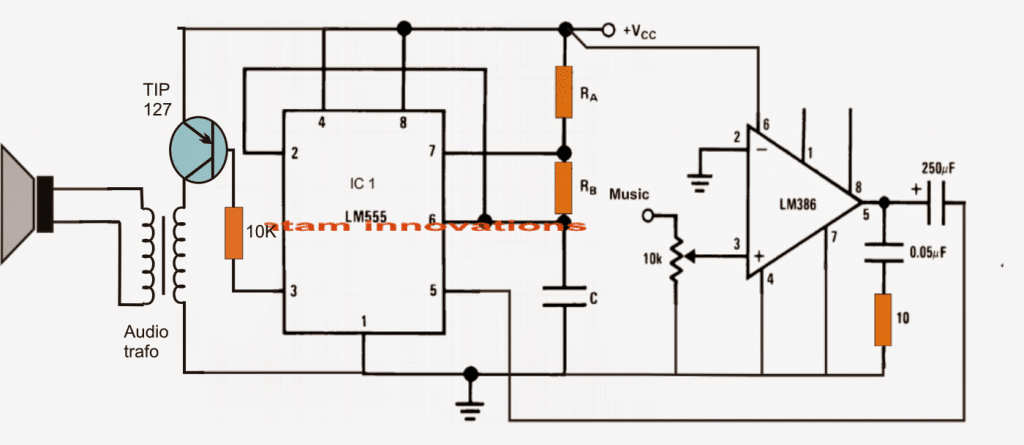In this article I have explained two simple class-D amplifier projects which can be built at home with extremely high efficiency results. A Class D amplifier is also known as switching amplifier. This technology uses pulse width modulation or PWM for digitally amplifying small analogue music signals into high power, high efficiency audio signals.
Why a Class D Amplifier
The main benefits of this type of amplifier are high efficiency, low cost, with the only drawback being the association of distortion if not cleaned with correctly calculated filters at the output.
Normally all amplifiers are analogue based where the input music or frequency is amplified in accordance with the same pattern that's being fed at the input.
Since a music may largely have exponentially rising and falling contents and also frequencies accompanied with all sorts of amplitudes causes heating up of the devices.
This happens because BJTs and mosfets do not "like" transitional inputs where the signal do not have sudden rise and fall rather gradually transits across the points where the devices are neither fully ON or OFF, this causes a lot of heat generation and power loss
In a class D type of amplifier, the music input is compared with high frequency triangle waves and converted into a PWM "language" at the output. The PWM content stores all the information of the music and translates it back into the connected loudspeaker in an amplified manner.
However since the PWMs will consist of non-exponential pulses where the pulses are in the form rectangular pillars switching ON/OFF suddenly without transitions can result in significant distortions at the output.
In order to smooth out the above issue, a low pass filter is generally incorporated wherein the spikes are smoothed to generate a reasonably good and clear amplified replication.
The proposed design of a class D digital amplifier circuit utilizes the famous 555 IC for the intended comparisons.
Instead of the PWM method here we use an alternative mode called the PPM or pulse position modulation which may be considered as good as a PWM.
Using Pulse Position Modulation
PPM is also known as pulse density modulation due to the specific nature of its functioning.
Here the modulation input is compared with high frequency triangle waves and the output is optimized by varying the position or the density of the generated/compared pulse output.
As can be seen in the below class D amplifier circuit design, the IC 555 is configured as a standard astable MV mode, where the resistors Ra, Rb and C determine the frequency of the triangle waves generated at pin6/7 of the IC.
The above high frequency triangle waves are compared with the music input applied at the control input pin5 of the IC.
Here the low voltage music signal is first amplified to some optimal voltage level and then applied at the control input pin#5 of the IC555.
This results in the discussed PPM output at pin#3 of the IC. This is amplified by T1 to a high current output and is fed to a loudspeaker for the required class D type amplification.
The audio trafo does a couple of interesting functions, it amplifies the output for the LS and also to an extent smooths out the harmonics which are normally a part of all class D type amplifier circuits.
A filter capacitor (non-polar) may be tried across the LS for obtaining cleaner sound outputs.
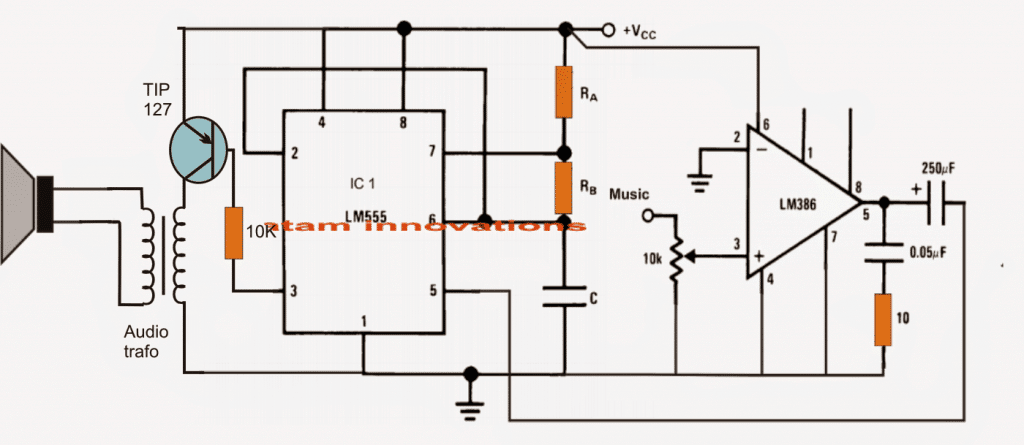
Parts List
- RA, RB, C = To be calculated with some trial and error
- 10 Ohm 1/4 watt resistor = 2nos
- 10K potentiometer = 1no
- IC 555 = 1no
- IC LM386 = 1no
- TIP127 transistor = 1no
- Audio Transformer = 1no
- Speaker 8 ohm 2 watts = 1no
IC 555 Pinout
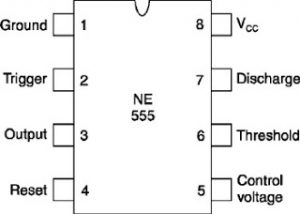
IC LM386 Pinouts
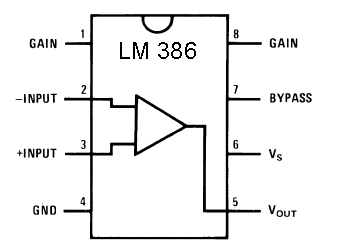
Switching Class-D Amplifier Circuit
Class-A and Class-B linear amplifiers are commonly employed to amplify audio signals. On the other hand, it might be also feasible to amplify audio signals using a nonlinear amplifier.
This kind of nonlinear amplifiers are generally called "switching" or Class-D amplifiers, since the output transistors found in these devices switch by either completely turning on or completely turning off.
In a switching amplifier, nearly all electrical power is transferred to the load (loudspeaker) during the periods when the amplifier transistors are fully turned on.
The greatest volume of power is dissipated through the transistors while the devices are in the switch-on and switch-off transitions.
The quicker the transition, the lesser the quantity of power given out through the output transistors.
Due to switching amplifiers' layout, the efficiency level of a switching amplifier can go well beyond 90%.
In contrast, Class-A and B amplifiers provide an utmost efficiencies of around 20% and 78.5%, respectively.
An additional advantage of the high efficiency of 'switching amplifiers is that these units have smaller dimensions, lighter in weight, and tend to be much cheaper than Class-A and B counterparts.
Switching Amplifiers makes use of a pulse-width modulator to get the necessary switching procedures.
Audio signals are first transformed into a train of pulses, each of the pulses being directly proportional with the instantaneous audio signal amplitudes in comparison with the fixed-frequency, fixed-amplitude, of the triangular waveform which is used as the reference.
Thus, with reference to the fixed frequency, the signal's amplitude alters the output's PWM (duty cycle).
The compared difference is then amplified and fed to a powerful 8 ohm loudspeaker, which responds by demodulating the PWMs and reproduce an amplified switched audio output.
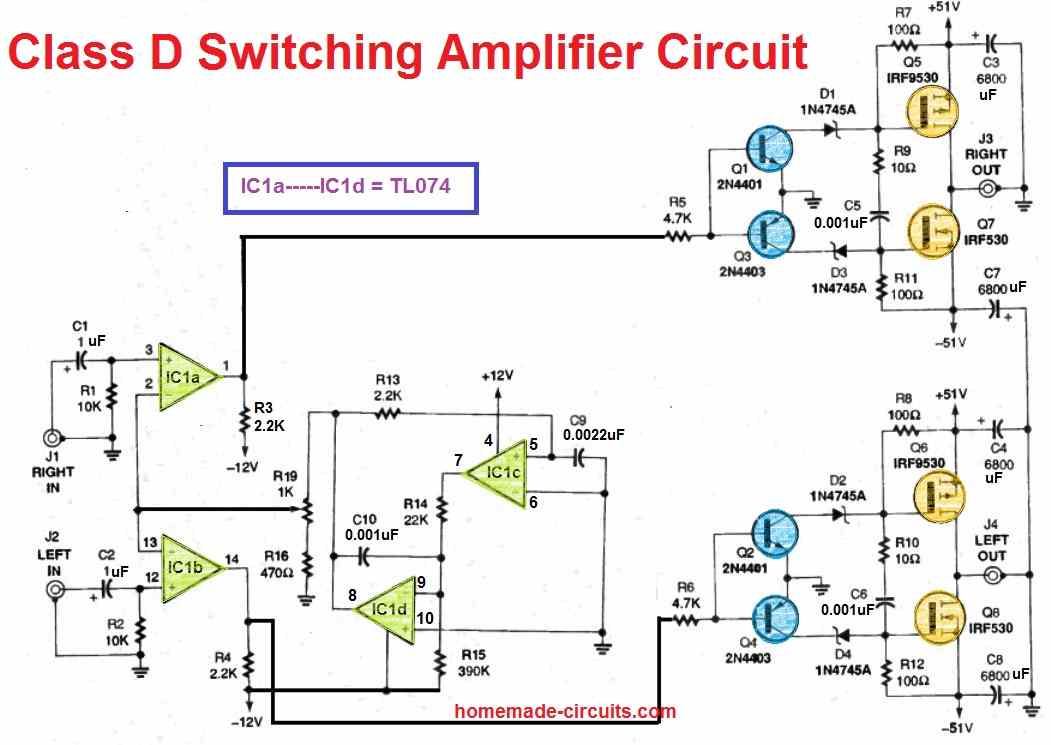
Voltage Splitter Circuit
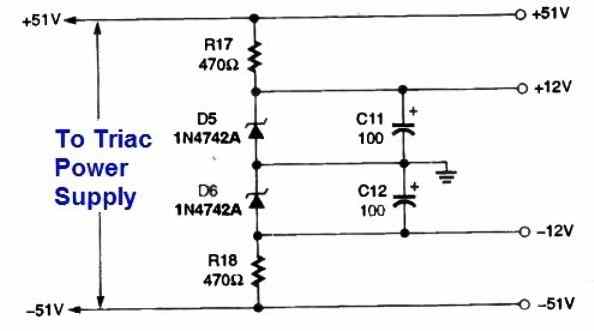
Power Supply Circuit
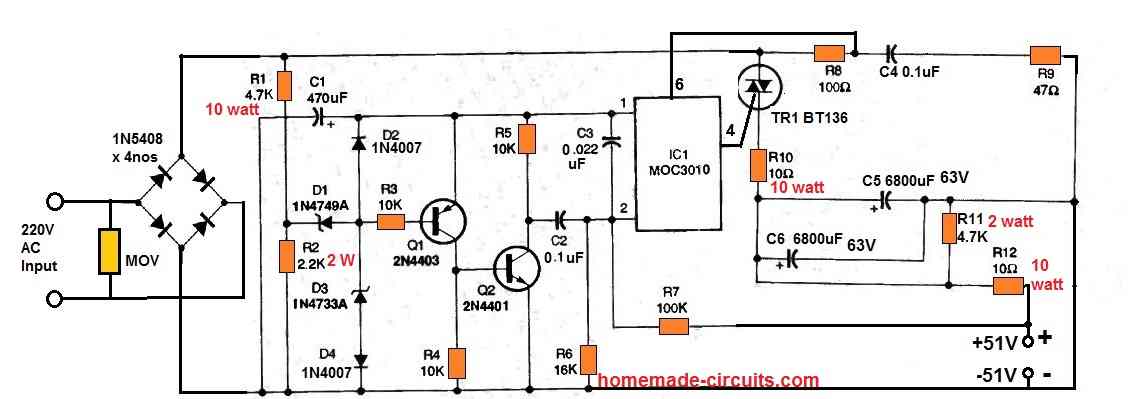
The above shown transformerless power supply may be compact but is not isolated from input AC mains, and is therefore extremely dangerous to touch in open and switched ON condition. Extreme caution is advised while building this circuit. If in doubt, it is better to use a transformer based power supply instead.
The circuit diagram for the Switching Amplifier can be seen in the above image. An independent 51 V DC supply is necessary to energize the Amplifier circuit.
The 51 V supply source is applied to a set of Zener diodes, D5 and D6, and it is smoothed through capacitors C11 and C12 in order to get a 12 V DC source for the amplifier circuit.
Additionally, portion of the 51 V DC source overrides the Zeners to supply the stages of the circuit which are supposed to work with 51 V DC directly.
How the Circuit Works
The right and left audio frequencies are applied to the switching Amplifier circuit via connectors J1 and J2, respectively.
A couple of stages of a TL074 op amp, IC1c and IC1d, produce a 4 V peak-to-peak, 50 kHz triangular reference waveform.
The produced waveform is subsequently applied to the potentiometer R19, that supplies a variable reference point to the voltage comparators.
This makes it possible for the amplifier to utilize the input signals with amplitudes which range from 1 volt peak-to-peak to 4 volts peak-to-peak.
The additional a pair of op amp sections, IC1a and IC1b, work as comparators to generate the pulse-width-modulating output for the left and right channels of the Amplifier.
In the amplifier right channel, the voltage comparator output is connected to the bipolar conversion circuit via a current limiting resistor, R5.
The converting circuit features a positive and negative "terminal"; Q1, D1, and R1 which act like the positive terminal, and Q3, D3, and R11 which form the negative terminal.
Both terminals are linked with ground by means of the emitters of transistors Q1 and Q3, delivering a reference level for the converter.
The converter set up leads to 17 volts appearing across Q1, Q3, and Zener-diodes D1 and D3.
Adequate amount of current is therefore available to defeat the power MOSFET gate capacitance; which switches on and off the power MOSFET complementary push-pull output stage Q5 and Q7, at a very fast rate.
The amplifier's right and left outputs are obtained from the jacks J3 and J4, respectively. The output is able to deliver a total power of 60 watt RMS to the connected 8 ohm speakers.
The speakers enable the demodulation of the signal and generate an amplified audio output. With output power at the peak, the current consumption from an 8 ohm dynamic speakers will be roughly 1.2 amperes at 51 V DC.
Power Supply
Next, I will talk about the power supply. The second figure shows the circuit diagram of the power supply circuit.
The AC voltage obtained from PL1 supplies to the bridge rectifier BR1, that delivers a fullwave output of roughly 165 V DC.
The configuration built around the parts R1, R2, D1, D3, and D4 produces a train of of 5 V pulses which supply a couple of essential characteristics:
First the pulses are utilized as a 5 V supply source intended for tailoring the pulse shape and monostable circuit by means of D2 and C1.
2nd, the pulses activate opto-coupler IC1 and triac TR1 through the pulse shaping configuration created using Q1, Q2, and R3 R5, and the monostable circuit structured around C2 and R6.
Resistor R2 fixes the highest PWM and consequently the highest level of output voltage. If no feedback is used, the unfiltered peak voltage can be approximately 90 volts.
To get the required 51 V output for the switching amplifier circuit, the feedback configuration built using R6, R7, and C3 reverse biases the opto-coupler anytime the output voltage becomes greater than 51 volts.
This subsequently pushes TR1 to switch off as the unfiltered voltage runs towards zero volts. The RC feedback circuitry therefore adjusts the output voltage by making an effort to alter the IC1's conducting status.
